Inclusion of Modified Snow Melting and Flood Processes in the SWAT Model
Abstract
1. Introduction
2. Study Site and Materials
2.1. Study Area
2.2. Materials
3. Methods
3.1. Introduction of the SWAT Model
3.2. The Concept of AT and the Differentiation of Snowfall and Rainfall
3.3. The Modified Day-Degree Algorithm
3.4. Calibration and Validation
4. Results
4.1. Temperature Threshold of Rain and Snow Differentiation
4.2. Best Parameter Set
4.3. Model Performance
4.4. Snowmelt and Accumulation Temperature
5. Discussion
5.1. Temperature Threshold
5.2. Model Performance
5.3. Snowmelt and AT
6. Conclusions
Author Contributions
Funding
Acknowledgments
Conflicts of Interest
References
- Gascoin, S.; Kinnard, C.; Ponce, R.; Lhermitte, S. Glacier Contribution to Streamflow in two Headwaters of the Huasco River, Dry Andes of Chile. Cryosphere Discuss. 2010, 4, 1099–1113. [Google Scholar] [CrossRef]
- Pelto, M.S. Quantifying Glacier Runoff Contribution to Nooksack River, Wa in 2013–15. In Proceedings of the AGU Fall Meeting, San Francisco, CA, USA, 14–18 December 2015. [Google Scholar]
- Swick, M. Partitioning the Contribution of Light Absorbing Aerosols to Snow and Glacier Melt Using a Novel Hyperspectral Microscopy Method. In Proceedings of the AGU Fall Meeting, New Orleans, LA, USA, 11–15 December 2017. [Google Scholar]
- Blöschl, G.; Reszler, C.; Komma, J. A Spatially Distributed Flash Flood Forecasting Model. Environ. Model. Softw. 2008, 23, 464–478. [Google Scholar] [CrossRef]
- Ye, J.; Li, Z.; Wang, Y. Study and Application of Flash Flood Warning Method for Ungauged Basins. J. Hydroelectr. Eng. 2013, 32, 15–19. [Google Scholar]
- Maidment, D.R. Developing a Spatially Distributed Unit Hydrograph by Using Gis. In Application of Geographic Information Systems in Hydrology and Water Resources Management; IAHS Publication: Vienna, Austria, 1993; pp. 181–192. [Google Scholar]
- Hock, R.; Rees, G.; Williams, M.W.; Ramirez, E. Contribution from Glaciers and Snow Cover to Runoff from Mountains in Different Climates. Hydrol. Process. 2010, 20, 2089–2090. [Google Scholar] [CrossRef]
- Luo, Y.; Arnold, J.; Liu, S.; Wang, X.; Chen, X. Inclusion of Glacier Processes for Distributed Hydrological Modeling at Basin Scale with Application to a Watershed in Tianshan Mountains, Northwest China. J. Hydrol. 2013, 477, 72–85. [Google Scholar] [CrossRef]
- Li, X.M.; Ma, Y.; Sun, Y.H.; Gong, H.; Li, X. Flood Hazard Assessment in Pakistan at Grid Scale. J. Geo-Inf. Sci. 2013, 15, 314–320. [Google Scholar] [CrossRef]
- Lian, J.; Gong, H.; Li, X.; Zhao, W.; Hu, Z. Design and Development of Flood/Waterlogging Disaster Risk Model Based on Arcobjects. J. Geo-Inf. Sci. 2009, 11, 376–381. [Google Scholar] [CrossRef]
- Chen, G. Chinese Mountain Development Report; The Commercial Press: Beijing, China, 2010. [Google Scholar]
- Gang, Z.; Pang, B.; Xu, Z.; Wang, Z.; Shi, R. Assessment on the Hazard of Flash Flood Disasters in China. J. Hydraul. Eng. 2016, 47, 1133–1142. [Google Scholar]
- Verdhen, A.; Chahar, B.R.; Sharma, O.P. Snowmelt Modelling Approaches in Watershed Models: Computation and Comparison of Efficiencies under Varying Climatic Conditions. Water Resour. Manag. 2014, 28, 3439–3453. [Google Scholar] [CrossRef]
- Tahir, A.A.; Chevallier, P.; Arnaud, Y.; Neppel, L.; Ahmad, B. Modeling Snowmelt-Runoff under Climate Scenarios in the Hunza River Basin, Karakoram Range, Northern Pakistan. J. Hydrol. 2011, 409, 104–117. [Google Scholar] [CrossRef]
- Gan, R.; Luo, Y.; Zuo, Q.; Sun, L. Effects of Projected Climate Change on the Glacier and Runoff Generation in the Naryn River Basin, Central Asia. J. Hydrol. 2015, 523, 240–251. [Google Scholar] [CrossRef]
- Troin, M.; Poulin, A.; Baraer, M.; Brissette, F. Comparing Snow Models under Current and Future Climates: Uncertainties and Implications for Hydrological Impact Studies. J. Hydrol. 2016, 540, 588–602. [Google Scholar] [CrossRef]
- Jost, G.; Moore, R.D.; Weiler, M.; Gluns, D.R.; Alila, Y. Use of Distributed Snow Measurements to Test and Improve a Snowmelt Model for Predicting the Effect of Forest Clear-Cutting. J. Hydrol. 2009, 376, 94–106. [Google Scholar] [CrossRef]
- Flynn, K.F. Evaluation of Swat for Sediment Prediction in a Mountainous Snowmelt-Dominated Catchment. Trans. Asabe 2011, 54, 113–122. [Google Scholar] [CrossRef]
- Kim, S.B.; Shin, H.J.; Park, M.; Kim, S.J. Assessment of Future Climate Change Impacts on Snowmelt and Stream Water Quality for a Mountainous High-Elevation Watershed Using Swat. Paddy Water Environ. 2015, 13, 557–569. [Google Scholar] [CrossRef]
- Millares, A.; Polo, M.J.; Moñino, A.; Herrero, J.; Losada, M.A. Bedload Dynamics and Associated Snowmelt Influence in Mountainous and Semiarid Alluvial Rivers. Geomorphology 2014, 206, 330–342. [Google Scholar] [CrossRef]
- Xie, Y. Analysis of Flood Causes and Classification Characteristics of the Tizinafu River. China Water Transp. 2014, 14, 221–222. [Google Scholar]
- Zhang, H.; Wei, W. Application of Weather Radar in Flood Early Warning. Adv. Sci. Technol. Water Resour. 1996, 3, 21–25. [Google Scholar]
- Zhang, X.Y.; Jia, L.I.; Yang, Y.Z.; You, Z. Runoff Simulation of the Catchment of the Headwaters of the Yangtze River Based on Swat Model. J. Northwest For. Univ. 2012, 5, 009. [Google Scholar] [CrossRef]
- Tian, Y.; Peterslidard, C.D.; Eylander, J.B.; Joyce, R.J.; Huffman, G.J.; Adler, R.F.; Hsu, K.; Turk, F.J.; Garcia, M.; Zeng, J. Parameter Values for Snowmelt Runoff Modelling. J. Hydrol. 1986, 84, 197–219. [Google Scholar]
- Anderson, E.A. A Point of Energy and Mass Balance Model of Snow Cover; National Oceanic and Atmospheric Administration Technical Report NWS 19; US Department of Commerce: Silver Springs, MD, USA, 1976; pp. 1–150.
- He, Z.H.; Parajka, J.; Tian, F.Q.; Blöschl, G. Estimating Degree-Day Factors from Modis for Snowmelt Runoff Modeling. Hydrol. Earth Syst. Sci. 2014, 11, 4773–4789. [Google Scholar] [CrossRef]
- Jones, H.G.; Sochanska, W.; Stein, J.; Roberge, J.; Plamondon, A.P.; Charette, J.Y. Snowmelt in a Boreal Forest Site: An Integrated Model of Meltwater Quality (Snoqual1); Springer: Dordrecht, The Netherlands, 1986. [Google Scholar]
- Larson, L.; Singh, V.P.; Frevert, D. National Weather Service River Forecast System (Nwsrfs); National Weather Service: Silver spring, MD, USA, 2002.
- Shimamura, Y.; Izumi, T.; Matsuyama, H. Remote Sensing of Areal Distribution of Snow Cover and Snow Water Resources in Mountains Based on Synchronous Observations of Landsat-7 Satellite: A Case Study around the Joetsu Border of Niigata Prefecture in Japan. Proc. Gen. Meet. Assoc. Jpn. Geogr. 2004. [Google Scholar] [CrossRef]
- Herrero, J.; Polo, M.J.; Moñino, A.; Losada, M.A. An Energy Balance Snowmelt Model in a Mediterranean Site. J. Hydrol. 2009, 371, 98–107. [Google Scholar] [CrossRef]
- Anderton, S.P.; White, S.M.; Alvera, B. Micro-Scale Spatial Variability and the Timing of Snow Melt Runoff in a High Mountain Catchment. J. Hydrol. 2002, 268, 158–176. [Google Scholar] [CrossRef]
- Snauffer, A.M.; Hsieh, W.W.; Cannon, A.J. Comparison of Gridded Snow Water Equivalent Products with in Situ Measurements in British Columbia, Canada. J. Hydrol. 2016, 541, 714–726. [Google Scholar] [CrossRef]
- Dziubanski, D.; Franz, K. Assimilation of Amsr-E Snow Water Equivalent Data in a Spatially-Lumped Snow Model. In Proceedings of the AGU Fall Meeting, San Francisco, CA, USA, 14–18 December 2015. [Google Scholar]
- Feng, T.; Feng, S. An Energy Balance Snowmelt Model for Application at a Continental Alpine Site. Procedia Eng. 2012, 37, 208–213. [Google Scholar] [CrossRef]
- Yu, W.; Zhao, Y.; Nan, Z.; Li, S. Improvement of Snowmelt Implementation in the Swat Hydrologic Model. Acta Ecol. Sin. 2013, 33, 6992–7001. [Google Scholar]
- Arnold, J.G.; Fohrer, N. Swat2000: Current Capabilities and Research Opportunities in Applied Watershed Modelling. Hydrol. Process. 2005, 19, 563–572. [Google Scholar] [CrossRef]
- Fontaine, T.A.; Cruickshank, T.S.; Arnold, J.G.; Hotchkiss, R.H. Development of a Snowfall–Snowmelt Routine for Mountainous Terrain for the Soil Water Assessment Tool (Swat). J. Hydrol. 2002, 262, 209–223. [Google Scholar] [CrossRef]
- Xu, C.; Chen, Y.; Hamid, Y.; Tashpolat, T.; Chen, Y.; Ge, H.; Li, W. Long-Term Change of Seasonal Snow Cover and Its Effects on River Runoff in the Tarim River Basin, Northwestern China. Hydrol. Process. 2010, 23, 2045–2055. [Google Scholar] [CrossRef]
- Arnold, J.G.; Muttiah, R.S.; Srinivasan, R.; Allen, P.M. Regional Estimation of Base Flow and Groundwater Recharge in the Upper Mississippi River Basin. J. Hydrol. 2000, 227, 21–40. [Google Scholar] [CrossRef]
- Zhang, Y.; Liu, S.; Ding, Y. Spatial Variation of Degree-Day Factors on the Observed Glaciers in Western China. Acta Geogr. Sin. 2006, 61, 89–98. [Google Scholar] [CrossRef]
- Zhang, Y.; Suzuki, K.; Kadota, T.; Ohata, T. Sublimation from Snow Surface in Southern Mountain Taiga of Eastern Siberia. J. Geophys. Res. Atmos. 2004, 109D21. [Google Scholar] [CrossRef]
- Wang, X.; Melesse, A.M. Evaluation of the Swat Model’s Snowmelt Hydrology in a Northwestern Minnesota Watershed. Trans. Asabe 2005, 48, 1359–1376. [Google Scholar] [CrossRef]
- Kumar, M.; Marks, D.; Dozier, J.; Reba, M.; Winstral, A. Evaluation of Distributed Hydrologic Impacts of Temperature-Index and Energy-Based Snow Models. Adv. Water Resour. 2013, 56, 77–89. [Google Scholar] [CrossRef]
- Jost, G.; Moore, R.D.; Smith, R.; Gluns, D.R. Distributed Temperature-Index Snowmelt Modelling for Forested Catchments. J. Hydrol. 2012, 420, 87–101. [Google Scholar] [CrossRef]
- Regine, H. A Distributed Temperature-Index Ice- and Snowmelt Model Including Potential Direct Solar Radiation. J. Glaciol. 1999, 45, 101–111. [Google Scholar]
- Cao, K.; Long, A.; Wang, J.; Liu, Y.; Cai, S.; Li, Y. Research and Application on Basin Accumulated Temperature Distribution (Atd) Model at the Snowmelt Flood Magnitude. J. North China Univ. Water Resour. Electr. Power (Nat. Sci. Ed.) 2017, 38, 10–18. [Google Scholar]
- Qi, L.; Ying, Z. Research on Winter Precipitation Types’ Discrimination Criterion in Eastern China. Meteorol. Mon. 2012, 38, 96–102. [Google Scholar]
- Zhang, F.; Zhang, H.; Hagen, S.C.; Ye, M.; Wang, D.; Gui, D.; Zeng, C.; Tian, L.; Liu, J. Snow Cover and Runoff Modelling in a High Mountain Catchment with Scarce Data: Effects of Temperature and Precipitation Parameters. Hydrol. Process. 2015, 29, 52–65. [Google Scholar] [CrossRef]
- Meng, X.; Ji, X.; Liu, Z.; Xiao, J.; Chen, X.; Wang, F. Research on Improvement and Application of Snowmelt Module in Swat. J. Nat. Resour. 2014, 29, 528–539. [Google Scholar]
- Braud, I.; Roux, H.; Anquetin, S.; Maubourguet, M.M.; Manus, C.; Viallet, P.; Dartus, D. The Use of Distributed Hydrological Models for the Gard 2002 Flash Flood Event: Analysis of Associated Hydrol. Process. J. Hydrol. 2010, 394, 162–181. [Google Scholar] [CrossRef]
- Vincendon, B.; Ducrocq, V.; Saulnier, G.M.; Bouilloud, L.; Chancibault, K.; Habets, F.; Noilhan, J. Benefit of Coupling the Isba Land Surface Model with a Topmodel Hydrological Model Version Dedicated to Mediterranean Flash-Floods. J. Hydrol. 2010, 394, 256–266. [Google Scholar] [CrossRef]
- Fuka, D.R.; Easton, Z.M.; Brooks, E.S.; Boll, J.; Steenhuis, T.S.; Walter, M.T. A Simple Process-Based Snowmelt Routine to Model Spatially Distributed Snow Depth and Snowmelt in the Swat Model. Jawra J. Am. Water Resour. Assoc. 2012, 48, 1151–1161. [Google Scholar] [CrossRef]
- Green, C.H.; Van Griensven, A. Autocalibration in Hydrologic Modeling: Using Swat2005 in Small-Scale Watersheds. Environ. Model. Softw. 2008, 23, 422–434. [Google Scholar] [CrossRef]
- Ahl, R.S.; Woods, S.W.; Zuuring, H.R. Hydrologic Calibration and Validation of Swat in a Snow-Dominated Rocky Mountain Watershed, Montana, U.S.A. Jawra J. Am. Water Resour. Assoc. 2010, 44, 1411–1430. [Google Scholar] [CrossRef]
- Engelhardt, M.; Schuler, T.V.; Andreassen, L.M. Runoff Modelling and the Contribution of Snow and Glacier Melt to the Discharge for Highly Glacierized Catchments in Norway. In Proceedings of the EGU General Assembly Conference 2013, Vienna, Austria, 7–12 April 2013. [Google Scholar]
- Haq, M. Snowmelt Runoff Investigation in River Swat Upper Basin Using Snowmelt Runoff Model, Remote Sensing and GIS Techniques; The International Institute for Geo-information Science and Earth: Enschede, The Netherlands, 2008. [Google Scholar]
- Dudley, R.W.; Hodgkins, G.A.; Mchale, M.R.; Kolian, M.J.; Renard, B. Trends in Snowmelt-Related Streamflow Timing in the Conterminous United States. J. Hydrol. 2017, 547, 208–221. [Google Scholar] [CrossRef]
- Tiwari, S.; Kar, S.C.; Bhatla, R. Snowfall and Snowmelt Variability over Himalayan Region in Inter-Annual Timescale. Aquat. Procedia 2015, 4, 942–949. [Google Scholar] [CrossRef]
- Huber, W.C.; Dickinson, R.E.; Barnwell, T.O. Storm Water Management Model, Version 4; U.S. Environmental Protection Agency: Washington, DC, USA, 1992.
- Ghodrati, B. Snowmelt runoff from Porsön residential area, Luleå. In Proceedings of the International Conference on Urban Storm Drainage, Gothenburg, Sweden, 4–6 June 1984. [Google Scholar]
- Bengtsson, L.; Westerström, G. Urban Snowmelt and Runoff in Northern Sweden. Int. Assoc. Sci. Hydrol. Bull. 1992, 37, 263–275. [Google Scholar] [CrossRef]
- Pomeroy, J.W.; Marks, D.; Link, T.; Ellis, C.; Hardy, J.; Rowlands, A.; Granger, R. The Impact of Coniferous Forest Temperature on Incoming Longwave Radiation to Melting Snow. Hydrol. Process. 2010, 23, 2513–2525. [Google Scholar] [CrossRef]
- Wang, X.; Luo, Y.; Sun, L.; Zhang, Y. Assessing the Effects of Precipitation and Temperature Changes on Hydrol. Process. in a Glacier-Dominated Catchment. Hydrol. Process. 2015, 29, 4830–4845. [Google Scholar] [CrossRef]
- Xiao, Y. A Method of Calculating Effective Accumulated Temperature Is Introduced Based on Daily Maximum and Minimum Temperature. Plant Prot. 1983, 9, 43–45. [Google Scholar]
- Watanabe, N.; Xiao, Y.Y. A Simple Method for Calculating Effective Accumulated Temperature Based on Daily Maximum and Minimum Temperature. Plant Prot. 1981, 2, 39–44. [Google Scholar]
- You, F.; Guo, L.; Shi, Y.; Zeng, J. Discrimination Index of Precipitation Phase State and Its Verification in Beijing. J. Meteorol. Environ. 2013, 29, 49–54. [Google Scholar]
- Li, J.; Li, G.; Pei, J.; Wang, F.; Wang, X.; Wen, J. Analysis on the Phase Transformation of Precipitation During a Strong Cold Wave Happened in Spring. Meteorol. Mon. 2009, 35, 87–94. [Google Scholar]
- Liu, J. The Study on the Application of Weather Radar Precipitation in Real-Time Flood Forecasting. Master’s Thesis, Hehai University, Nanjing, China, 2003. [Google Scholar]
- Zhang, L.; Guo, R.; Zeng, J.; Lu, B.; Duan, L.; Liu, L.; Sun, Z. Research on Discrimination Criterion of Precipitation Types in Beijing in Winter. Plateau Meteorol. 2013, 32, 1780–1786. [Google Scholar]
- Nash, J.E.; Sutcliffe, J.V. River Flow Forecasting through Conceptual Models Part I—A Discussion of Principles. J. Hydrol. 1970, 10, 282–290. [Google Scholar] [CrossRef]
- Moriasi, D.N.; Arnold, J.G.; Van Liew, M.W.; Bingner, R.L.; Harmel, R.D.; Veith, T.L. Model Evaluation Guidelines for Systematic Quantification of Accuracy in Watershed Simulations. Trans. Asabe 2007, 50, 885–900. [Google Scholar] [CrossRef]
- Clow, D.W. Changes in the Timing of Snowmelt and Streamflow in Colorado: A Response to Recent Warming. J. Clim. 2010, 23, 2293–2306. [Google Scholar] [CrossRef]
- Stone, R.S.; Dutton, E.G.; Harris, J.M.; Longenecker, D. Earlier Spring Snowmelt in Northern Alaska as an Indicator of Climate Change. J. Geophys. Res. Atmos. 2002, 107. [Google Scholar] [CrossRef]
- Ficklin, D.L.; Barnhart, B.L. Corrigendum to “Swat Hydrologic Model Parameter Uncertainty and Its Implications for Hydroclimatic Projections in Snowmelt-Dependent Watersheds. J. Hydrol. 2015, 527, 1189. [Google Scholar] [CrossRef]
- Dahri, Z.H.; Ahmad, B.; Leach, J.H.; Ahmad, S. Satellite-Based Snowcover Distribution and Associated Snowmelt Runoff Modeling in Swat River Basin of Pakistan. Proc. Pak. Acad. Sci. 2011, 48, 19–32. [Google Scholar]
- Engelhardt, M.; Schuler, T.V.; Andreassen, L.M. Contribution of Snow and Glacier Melt to Discharge for Highly Glacierised Catchments in Norway. Hydrol. Earth Syst. Sci. 2014, 18, 511–523. [Google Scholar] [CrossRef]
- Wang, L.; Zhang, X.H.; Liu, Z. Calculation Method of Snow Melting Flood in the Middle and High Mountain Area Xinjiang. Electr. Power Surv. Des. 2016, 10, 72–75. [Google Scholar]
- Bowyer, A. Variation Trends and Multi-Scale Analysis of Flood Affected Area in Various Regions of Xinjiang. Acta Geogr. Sin. 2008, 63, 769–779. [Google Scholar]
- Tan, Y.; Mao, W.; Li, X.; Wang, H. Study on the Models of Predicting the Annual Accumulated Temperature in the Main Cotton-Production Regions in Xinjiang. Arid Zone Res. 2005, 22, 259–263. [Google Scholar]
- Zhou, Z.; Bi, Y. Improvement of Swat Model and Its Application in Simulation of Snowmelt Runoff. In Proceedings of the National Symposium on Ice Engineering, Hohhot, China, 1 July 2011. [Google Scholar]
- Sexton, A.M.; Sadeghi, A.M.; Zhang, X.; Srinivasan, R.; Shirmohammadi, A. Using Nexrad and Rain Gauge Precipitation Data for Hydrologic Calibration of Swat in a Northeastern Watershed. Trans. ASABE 2010, 53, 1501–1510. [Google Scholar] [CrossRef]
- Richard, C.; Gratton, D.J. The Importance of the Air Temperature Variable for the Snowmelt Runoff Modelling Using SRM. Hydrol. Process. 2010, 15, 3357–3370. [Google Scholar] [CrossRef]
- Mernild, S.H.; Liston, G.E. The Influence of Air Temperature Inversions on Snowmelt and Glacier Mass Balance Simulations, Ammassalik Island, Southeast Greenland. J. Appl. Meteorol. Climatol. 2010, 49, 47–67. [Google Scholar] [CrossRef]
- Cazorzi, F.; Dalla Fontana, G. Snowmelt Modelling by Combining Air Temperature and a Distributed Radiation Index. J. Hydrol. 1996, 181, 169–187. [Google Scholar] [CrossRef]
- Lu, X.Y.; Xie, G.H.; Li, Y.; Chen, S.J. Variation Characteristics of Snow Cover and the Relation to Air Temperature and Precipitation in Manasi River Basin. Desert Oasis Meteorol. 2010, 4, 35–39. [Google Scholar]
- Zhao, C.Y.; Yan, X.Y.; Li, D.L.; Wang, Y.; Luo, Y. The Variation of Snow Cover and Its Relationship to Air Temperature and Precipitation in Liaoning Province During 1961–2007. J. Glaciol. Geocryol. 2010, 32, 461–468. [Google Scholar]
- Xu, L.; Wu, B. Relationship between Eurasian Snow Cover and Late-Spring and Early-Summer Rainfall in China in 2010. Plateau Meteorol. 2012, 31, 706–714. [Google Scholar]
- Fu, H.; Jia, H. Snowfall Estimation of Maximum Possible Snow Melt in Midsummer in Kumalake River Basin. Arid Land Geogr. 2012, 35, 193–199. [Google Scholar]
- Wang, P.; Mu, Z. Study on Relationship of Snowmelt Runoff with Snow Area and Temperature in Km River Basin. J. Water Resour. Water Eng. 2013, 24, 28–31. [Google Scholar]
- Zhou, Y.; Xu, W.; Zhang, J.; Bai, A.; Liu, X.; Xu, G. A Comparative Analysis of the Two Dynamic Snow-Melting Process and Their Relationship with Air Temperature During 2013–2015 in the Area of Maduo, Tibetan Plateau. J. Nat. Resour. 2017, 32, 101–113. [Google Scholar]
- Aizen, V.B.; Aizen, E.M.; Nesterov, V.N.; Sexton, D.D. A Study of Glacial Runoff Regime in Central Tien Shan During 1989–1990. J. Glaciol. Geocryol. 1993, 3, 442–459. [Google Scholar]
- Zhang, Y.; Luo, Y.; Sun, L. Quantifying Future Changes in Glacier Melt and River Runoff in the Headwaters of the Urumqi River, China. Environ. Earth Sci. 2016, 75, 770. [Google Scholar] [CrossRef]
- Rulin, O.; Liliang, R.; Weiming, C.; Zhongbo, Y. Application of Hydrological Models in a Snowmelt Region of Aksu River Basin. Water Sci. Eng. 2008, 1, 1–13. [Google Scholar]
- Hock, R.; Jansson, P.; Braun, L.N. Modelling the Response of Mountain Glacier Discharge to Climate Warming; Springer: Dordrecht, The Netherlands, 2005. [Google Scholar]
- Hock, R. Temperature Index Melt Modelling in Mountain Areas. J. Hydrol. 2003, 282, 104–115. [Google Scholar] [CrossRef]
- Zhang, R.; Liang, T.; Guo, J.; Xie, H.; Feng, Q.; Aimaiti, Y. Grassland Dynamics in Response to Climate Change and Human Activities in Xinjiang from 2000 to 2014. Sci. Rep. 2018, 8, 2888. [Google Scholar] [CrossRef] [PubMed]
- Iwata, Y.; Nemoto, M.; Hasegawa, S.; Yanai, Y.; Kuwao, K.; Hirota, T. Influence of Rain, Air Temperature, and Snow Cover on Subsequent Spring-Snowmelt Infiltration into Thin Frozen Soil Layer in Northern Japan. J. Hydrol. 2011, 401, 165–176. [Google Scholar] [CrossRef]
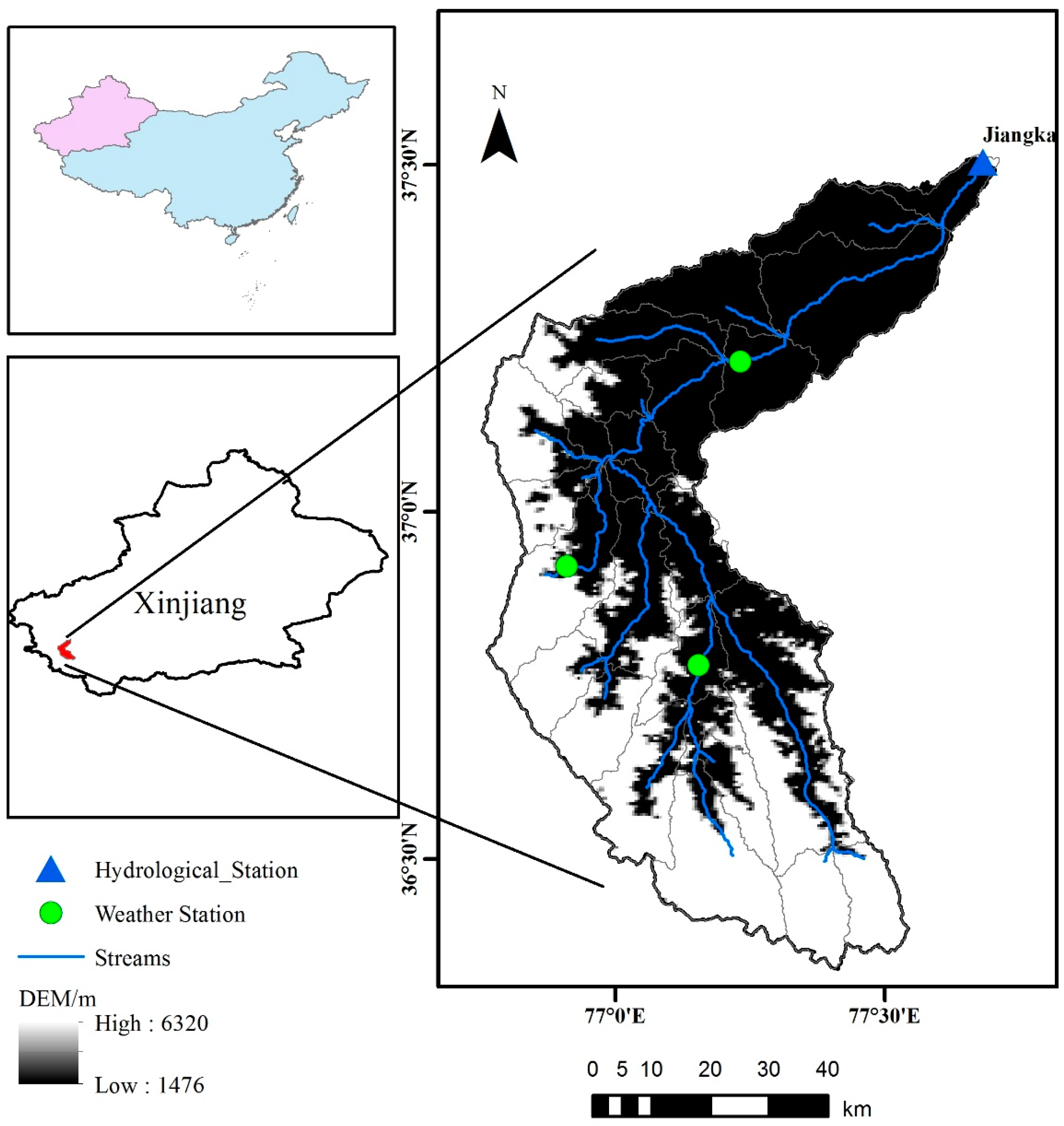
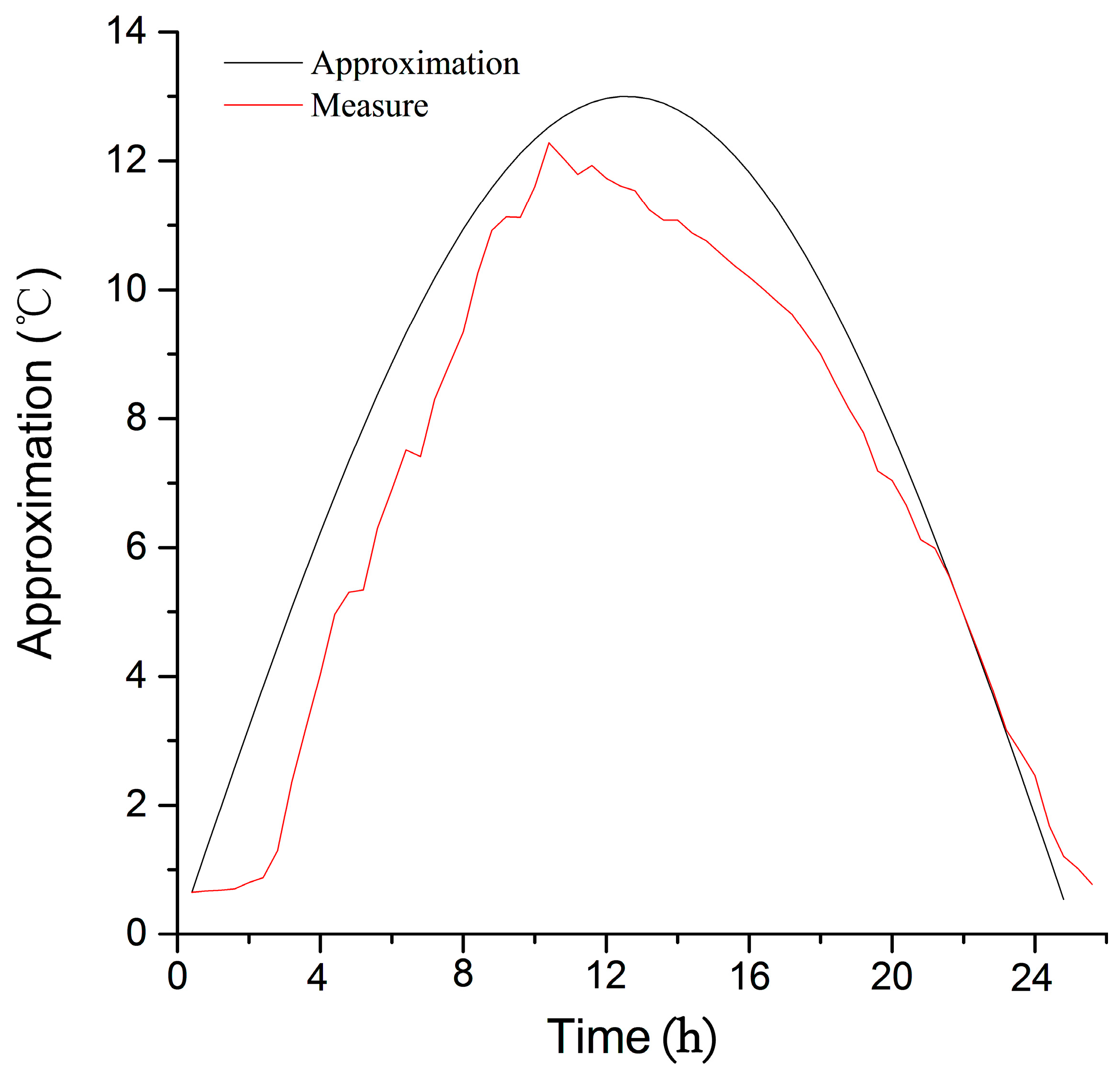

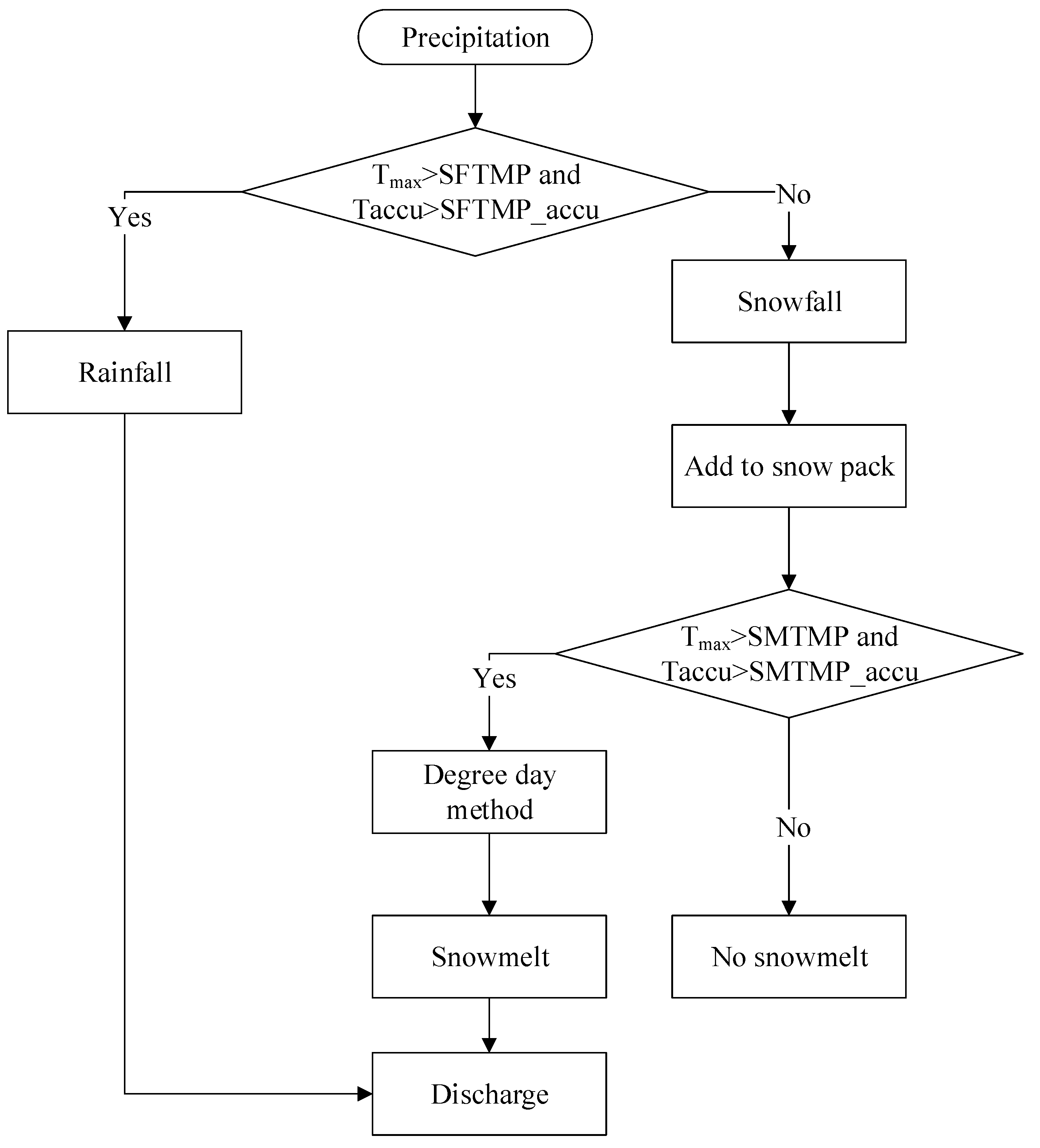
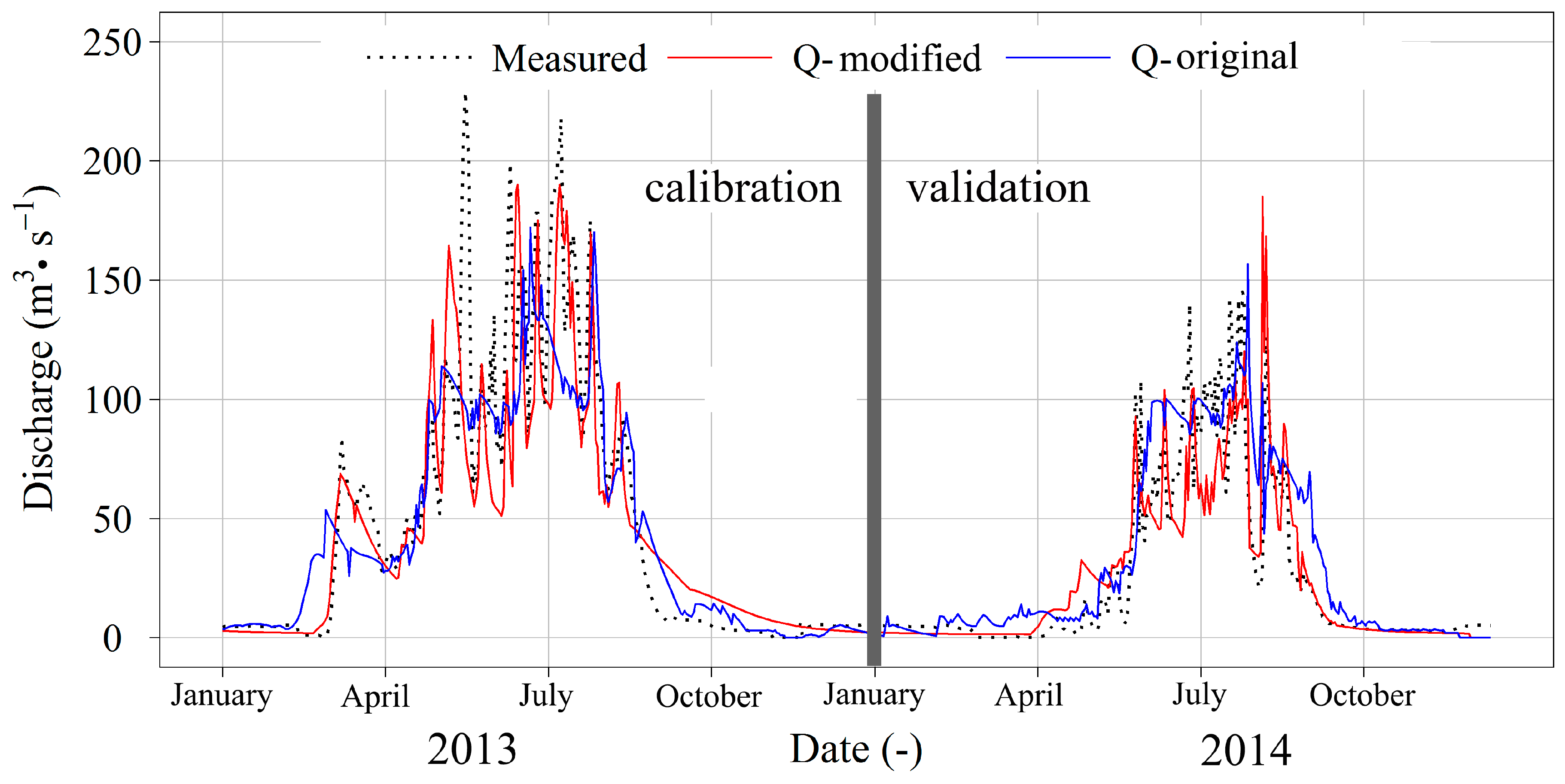
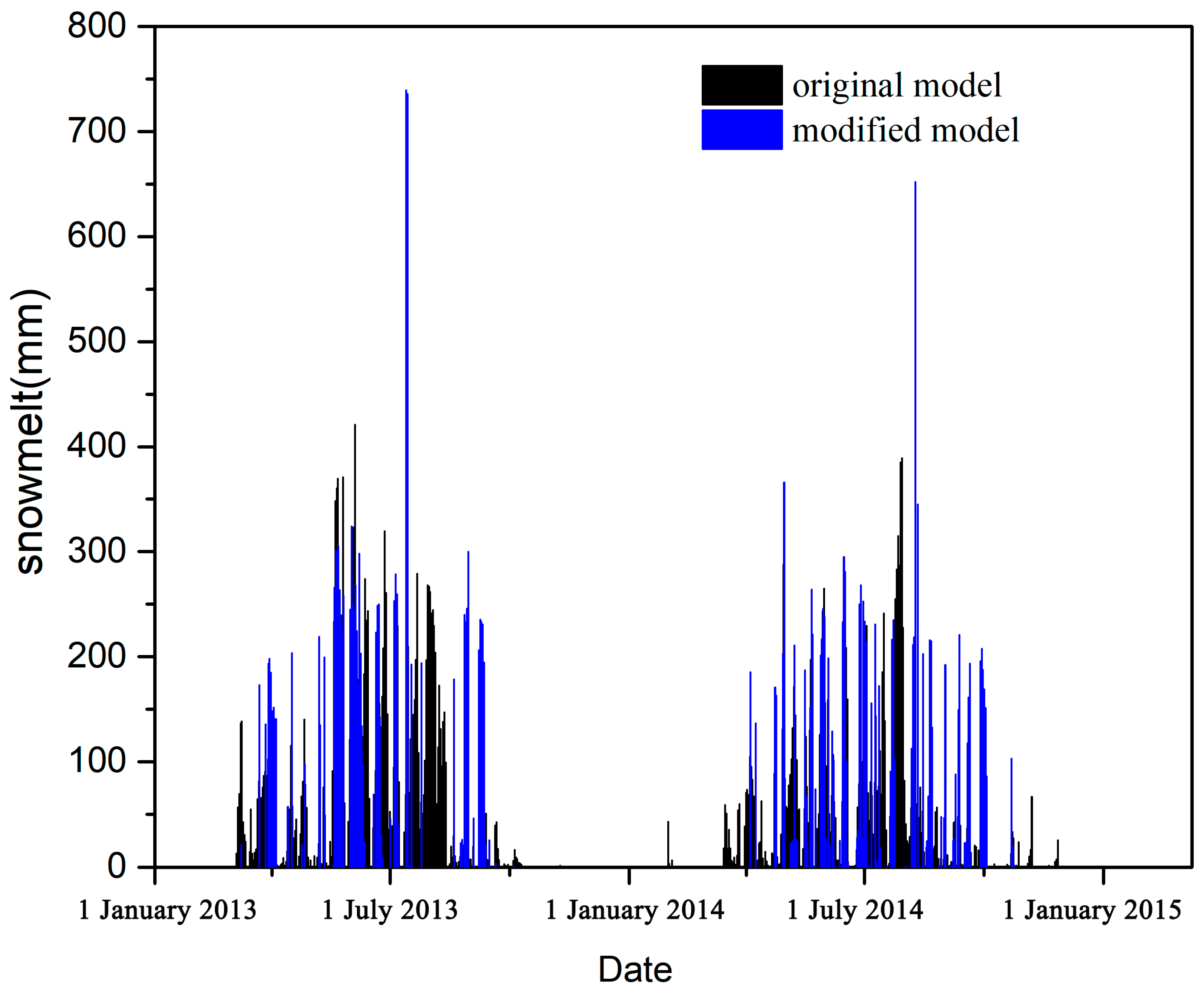
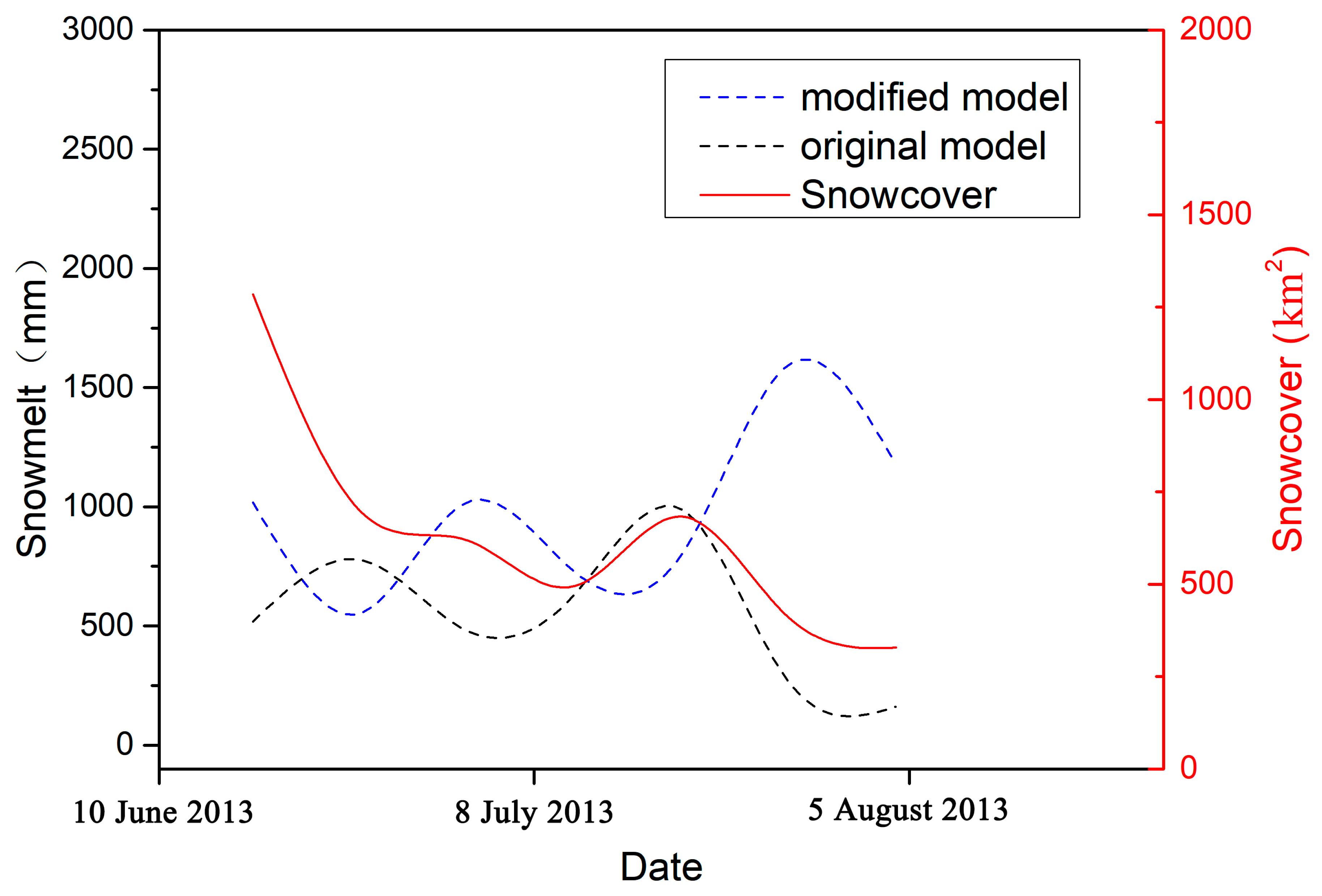
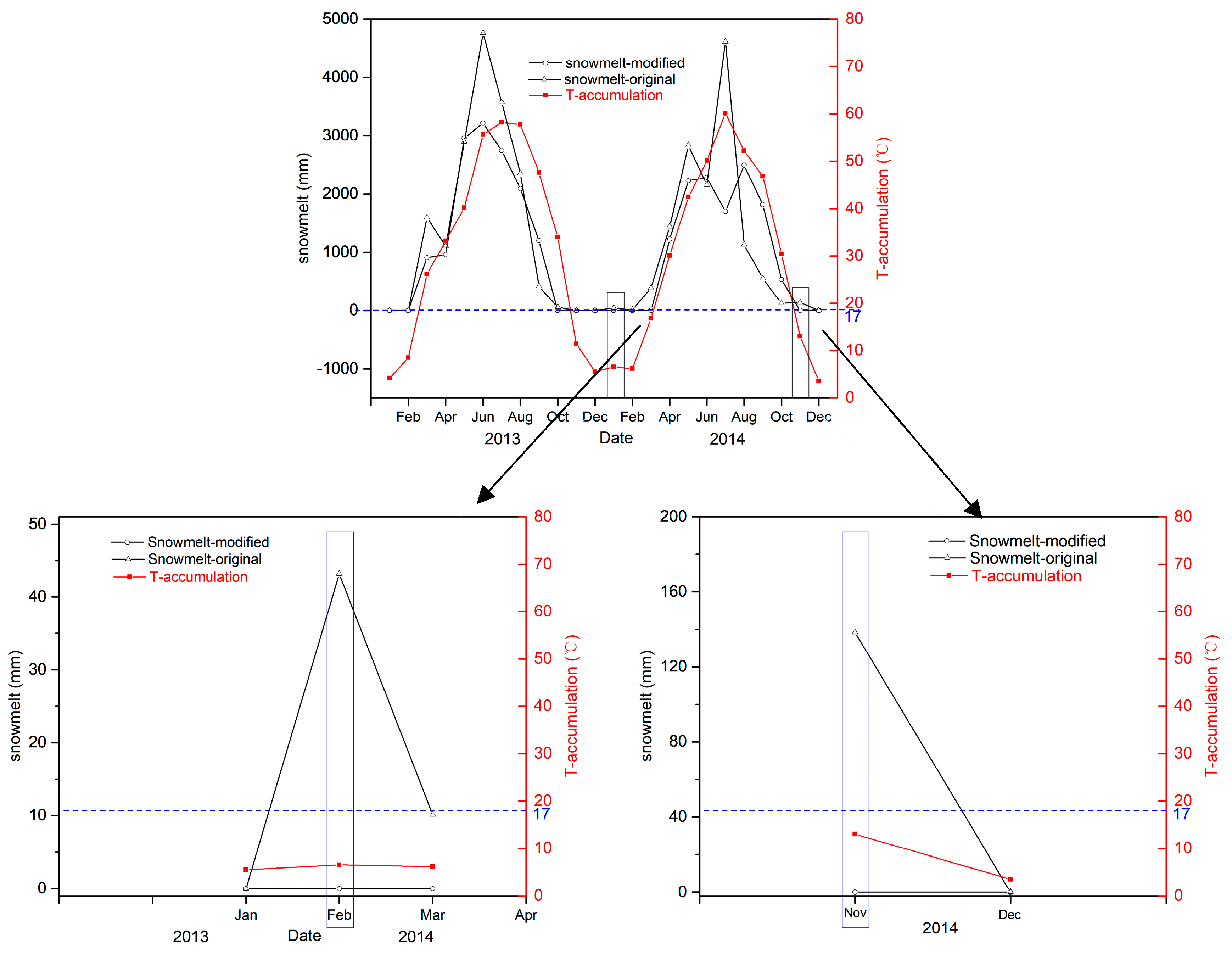
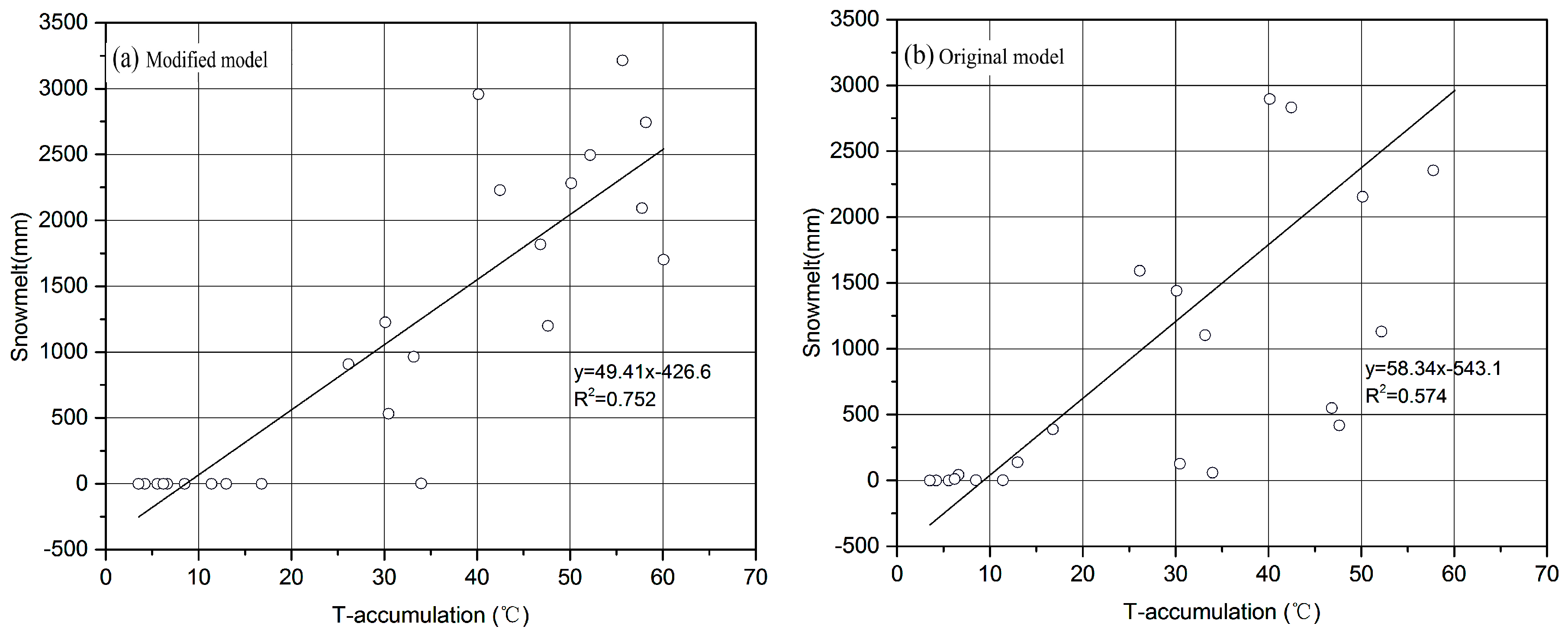
| Sites | Momuke | Kudi | Xihexiu | |||||||||
|---|---|---|---|---|---|---|---|---|---|---|---|---|
| Rainfall Temperature/°C | Snowfall Temperature/°C | Rainfall Temperature/°C | Snowfall Temperature/°C | Rainfall Temperature/°C | Snowfall Temperature/°C | |||||||
| AT | MT | AT | MT | AT | MT | AT | MT | AT | MT | AT | MT | |
| 2013 | 41.68 | 16.22 | 30.03 | 14.97 | 28.8 | 13.03 | 18.08 | 9.37 | 26.05 | 11.73 | 2.9 | 1.41 |
| 2014 | 40.86 | 16.37 | 39.21 | 18.87 | 35.96 | 15.04 | 28.59 | 14.03 | 11.21 | 5.65 | 11.25 | 5.79 |
| Average | 41.27 | 16.29 | 34.62 | 16.92 | 32.38 | 14.04 | 23.33 | 11.7 | 18.63 | 8.69 | 7.08 | 3.6 |
| Parameter | Unit | Description | Calibrated Value |
|---|---|---|---|
| SFTMP | °C | Snowfall temperature | 3.24 |
| SFTMP_accu | °C | Snowfall AT | 23 |
| SMTMP | °C | Snow melt base temperature | 2.97 |
| SMTMP_accu | °C | Snow melt base AT | 17 |
| SMFMX | mm H2O/°C-day | Melt factor for snow on 21 June | 7.87 |
| SMFMN | mm H2O/°C-day | Melt factor for snow on 21 December | 9.49 |
| TPLAS | °C·km−1 | Temperature lapse rate | −7.31 |
| PLAPS | mm·km−1 | Precipitation lapse rate | 21 |
| NSE | R2 | PBIAS (%) | |
|---|---|---|---|
| Original | |||
| Calibration (2013) | 0.71 | 0.89 | 5.79 |
| Validation (2014) | 0.64 | 0.75 | −18.04 |
| Overall (2013–2014) | 0.66 | 0.80 | 7.30 |
| Modified | |||
| Calibration (2013) | 0.75 | 0.89 | 7.30 |
| Validation (2014) | 0.69 | 0.81 | 2.89 |
| Overall (2013–2014) | 0.70 | 0.84 | 6.79 |
| Sort | Original Model | Modified Model | ||||
|---|---|---|---|---|---|---|
| Parameter | T-Stat | P-Value | Parameter | T-Stat | P-Value | |
| 1 | SMTMP | 0.05 | 0.86 | SMTMP | 0.04 | 0.94 |
| 2 | SNO_SUB | −0.08 | 0.83 | TLAPS | 0.04 | 0.93 |
| 3 | TLAPS | −0.33 | 0.74 | SMTMP_accu | −0.1 | 0.92 |
| 4 | SNOCOVMX | −0.34 | 0.68 | SFTMP_accu | 0.14 | 0.88 |
| 5 | SFTMP | −0.37 | 0.64 | SFTMP | 0.19 | 0.86 |
| 6 | SMFMX | 0.40 | 0.58 | SNO_SUB | 0.23 | 0.81 |
| 7 | PLAPS | −0.49 | 0.55 | PLAPS | 0.32 | 0.74 |
| 8 | ESCO | −0.79 | 0.43 | SMFMN | 0.67 | 0.68 |
| 9 | SOL_AWC | 0.83 | 0.41 | SNOCOVMX | 0.62 | 0.62 |
| 10 | SMFMN | 2.78 | 0.01 | SMFMX | 0.58 | 0.59 |
© 2018 by the authors. Licensee MDPI, Basel, Switzerland. This article is an open access article distributed under the terms and conditions of the Creative Commons Attribution (CC BY) license (http://creativecommons.org/licenses/by/4.0/).
Share and Cite
Duan, Y.; Liu, T.; Meng, F.; Luo, M.; Frankl, A.; De Maeyer, P.; Bao, A.; Kurban, A.; Feng, X. Inclusion of Modified Snow Melting and Flood Processes in the SWAT Model. Water 2018, 10, 1715. https://doi.org/10.3390/w10121715
Duan Y, Liu T, Meng F, Luo M, Frankl A, De Maeyer P, Bao A, Kurban A, Feng X. Inclusion of Modified Snow Melting and Flood Processes in the SWAT Model. Water. 2018; 10(12):1715. https://doi.org/10.3390/w10121715
Chicago/Turabian StyleDuan, Yongchao, Tie Liu, Fanhao Meng, Min Luo, Amaury Frankl, Philippe De Maeyer, Anming Bao, Alishir Kurban, and Xianwei Feng. 2018. "Inclusion of Modified Snow Melting and Flood Processes in the SWAT Model" Water 10, no. 12: 1715. https://doi.org/10.3390/w10121715
APA StyleDuan, Y., Liu, T., Meng, F., Luo, M., Frankl, A., De Maeyer, P., Bao, A., Kurban, A., & Feng, X. (2018). Inclusion of Modified Snow Melting and Flood Processes in the SWAT Model. Water, 10(12), 1715. https://doi.org/10.3390/w10121715






